

|
| DEUTSCHLAND | GERMANY |
| Bundesland: Freistaat Bayern | Bavaria |
| Regierungsbezirk: Schwaben | |
| Landkreis: Lindau (Bodensee) |
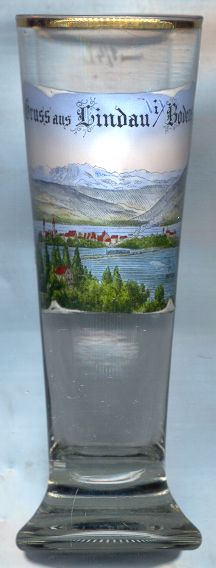
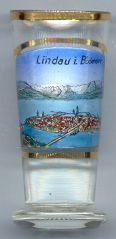 The old town of Lindau is situated on an island off the northeastern shore of the Bodensee (Lake Constance).
The first mention in a document dates from 882 AD and referred to a cloister that had been founded here already several decades before.
The cloister had opened a market on the lake shore, but later transferred this market onto the island in 1079. This became the beginning of Lindau's
history as a trading town. Around 1274/75, Lindau became an independent Imperial city. In 1528, Lindau became Protestant, but the whole surrounding
parts of the area on shore, and even the noble Ladies' convent on the island remained catholic. Lindau was one of the few Protestant cities
that did not sign the 'Confessio Augustana' (Augsburger Bekenntnis), which was delivered to the Emperor at the Diet of
Augsburg in 1530. Instead, the reformer Martin Bucer (Butzer) drew up the 'Confessio Tetrapolitana' (Vierstädtebekenntnis) together
with Konstanz, Memmingen and Straßburg (Strasbourg). In 1728, most parts of the old town were destroyed by
a large fire. After the fire, the town was rebuilt in Baroque style. In 1805/06, Lindau became part of the Kingdom of Bavaria.
In 1835, a dam for the railway was built to connect the shore with the island. The new harbour of the town was opened in 1856.
After World War II, the district Lindau was the only part of Bavaria that was occupied by French Allied troops.
In 1955, Lindau became part of Bavaria again.
The old town of Lindau is situated on an island off the northeastern shore of the Bodensee (Lake Constance).
The first mention in a document dates from 882 AD and referred to a cloister that had been founded here already several decades before.
The cloister had opened a market on the lake shore, but later transferred this market onto the island in 1079. This became the beginning of Lindau's
history as a trading town. Around 1274/75, Lindau became an independent Imperial city. In 1528, Lindau became Protestant, but the whole surrounding
parts of the area on shore, and even the noble Ladies' convent on the island remained catholic. Lindau was one of the few Protestant cities
that did not sign the 'Confessio Augustana' (Augsburger Bekenntnis), which was delivered to the Emperor at the Diet of
Augsburg in 1530. Instead, the reformer Martin Bucer (Butzer) drew up the 'Confessio Tetrapolitana' (Vierstädtebekenntnis) together
with Konstanz, Memmingen and Straßburg (Strasbourg). In 1728, most parts of the old town were destroyed by
a large fire. After the fire, the town was rebuilt in Baroque style. In 1805/06, Lindau became part of the Kingdom of Bavaria.
In 1835, a dam for the railway was built to connect the shore with the island. The new harbour of the town was opened in 1856.
After World War II, the district Lindau was the only part of Bavaria that was occupied by French Allied troops.
In 1955, Lindau became part of Bavaria again.
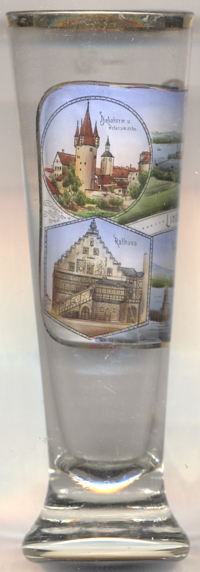
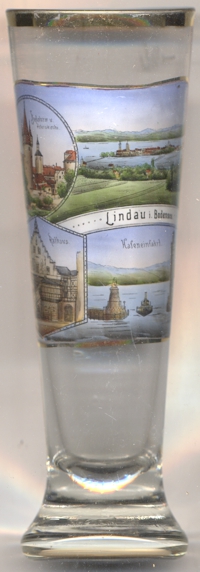
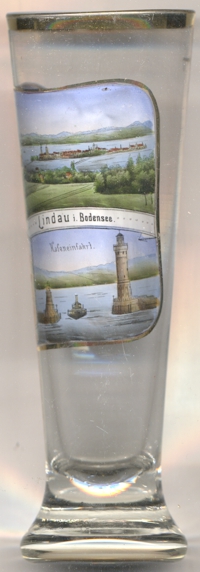
The  Diebsturm ('Thiefs' Tower') [near left, no. 4271: top left picture, left]
was built in 1380 on the western end of the old town as part of the town's fortifications. For a long time it was used as a prison, hence it's
name, 'Thief's Tower'.
Diebsturm ('Thiefs' Tower') [near left, no. 4271: top left picture, left]
was built in 1380 on the western end of the old town as part of the town's fortifications. For a long time it was used as a prison, hence it's
name, 'Thief's Tower'.
The  Peterskirche (St. Peter's church) [near left, no. 4271: top left picture, centre background]
is the oldest church of Lindau. It is probable that the church goes back to a wooden chapel built in this place for a fisermen's settlement, hence the
dedication to St. Peter. That chapel was later replaced by a stone church. When St. Stephen's was built as a parish church in 1180,
St. Peter's lost its importance as it became only a filial church. In the first half of the 13th century the nave was prolonged on the
western end. The church tower was rebuilt in 1425. The church further lost importance after the introduction of the Protestant faith in Lindau in 1528.
Towards the end of the 17th century (the exact date is not known), the church was exsecrated and became used as a storage facility. Plans in 1811
called for a demolision of both St. Peter's and the Thieves' Tower in order to recover stones for the construction of the new harbour; however,
both structures could be saved. Since 1928, the church is used as a war memorial.
Peterskirche (St. Peter's church) [near left, no. 4271: top left picture, centre background]
is the oldest church of Lindau. It is probable that the church goes back to a wooden chapel built in this place for a fisermen's settlement, hence the
dedication to St. Peter. That chapel was later replaced by a stone church. When St. Stephen's was built as a parish church in 1180,
St. Peter's lost its importance as it became only a filial church. In the first half of the 13th century the nave was prolonged on the
western end. The church tower was rebuilt in 1425. The church further lost importance after the introduction of the Protestant faith in Lindau in 1528.
Towards the end of the 17th century (the exact date is not known), the church was exsecrated and became used as a storage facility. Plans in 1811
called for a demolision of both St. Peter's and the Thieves' Tower in order to recover stones for the construction of the new harbour; however,
both structures could be saved. Since 1928, the church is used as a war memorial.
The  old town hall [near left, no. 4271: bottom left picture]
was originally built in Gothic style in 1422 and rebuilt in 1576 in Renaissance style with its characteristic stepped gable. The façade facing
Bismarckplatz is also adorned with a large, covered, originally wooden staircase that ends in a bay window. In the 19th century, the southern front
was lavishly decorated with historical paintings depicting the history of Lindau. The Imperial Diet of 1496/1497, convened by Emperor Maximilian I,
was held in the Gothic Council Chamber. Underneath, in the former market hall, parts of the Imperial City Library are still preserved.
old town hall [near left, no. 4271: bottom left picture]
was originally built in Gothic style in 1422 and rebuilt in 1576 in Renaissance style with its characteristic stepped gable. The façade facing
Bismarckplatz is also adorned with a large, covered, originally wooden staircase that ends in a bay window. In the 19th century, the southern front
was lavishly decorated with historical paintings depicting the history of Lindau. The Imperial Diet of 1496/1497, convened by Emperor Maximilian I,
was held in the Gothic Council Chamber. Underneath, in the former market hall, parts of the Imperial City Library are still preserved.
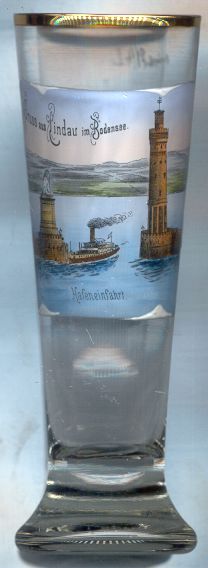
The  port entrance [left, no. 1352] with the sculpture of the Bavarian Lion (6 m high)
and the lighthouse (33 m high), completed in 1856, is the beloved landmark of Lindau.
The port is considered to be the most beautiful of all harbours on the lake.
port entrance [left, no. 1352] with the sculpture of the Bavarian Lion (6 m high)
and the lighthouse (33 m high), completed in 1856, is the beloved landmark of Lindau.
The port is considered to be the most beautiful of all harbours on the lake.
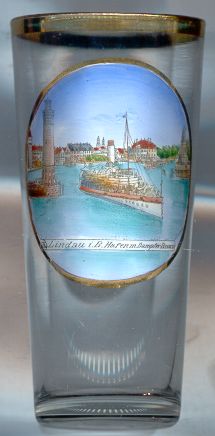
The picture on glass no. 1353 [left] shows the  steamship Bavaria II
steamship Bavaria II
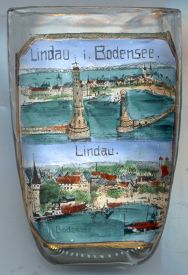
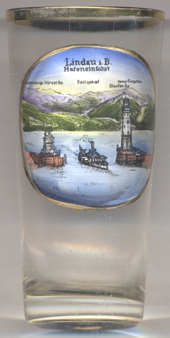
Glass no. 3537 [near left] also shows a view of Lindau harbour looking south over Lake Constance
towards the eastern, Austrian, end of the lake. The picture identified several mountains of the
Bregenzerwald Mountains in the background (from left/northeast to right/southwest):
Guntenhänge (Hangspitze 1,748 m, Guntenkopf 1,811 m), Mörzelspitze (1,830 m), Rechenkopf (?),
Staufenspitze (1,456 m), and Hoher Freschen (2,004 m).
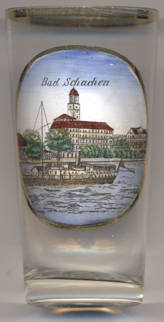 The history of Schachen as a spa goes back to 1474 when an iron-sulfur source was discovered. The spa facilities grew slowly
throughout the centuries. With the opening in 1853 of the railway line from Munich to Lindau
many tourists began to visit Lake Constance. The new
The history of Schachen as a spa goes back to 1474 when an iron-sulfur source was discovered. The spa facilities grew slowly
throughout the centuries. With the opening in 1853 of the railway line from Munich to Lindau
many tourists began to visit Lake Constance. The new
 Hotel
Hotel
Another place of the same name is Lindau, part of the municipality of Zerbst / Anhalt.
[https://de.wikipedia.org/wiki/Lindau_(Bodensee);
https://de.wikipedia.org/wiki/Bad_Schachen, https://de.wikipedia.org/wiki/Hoyren;
https://de.wikipedia.org/wiki/Peterskirche_(Lindau)]
![[scale]](lineal.jpg)